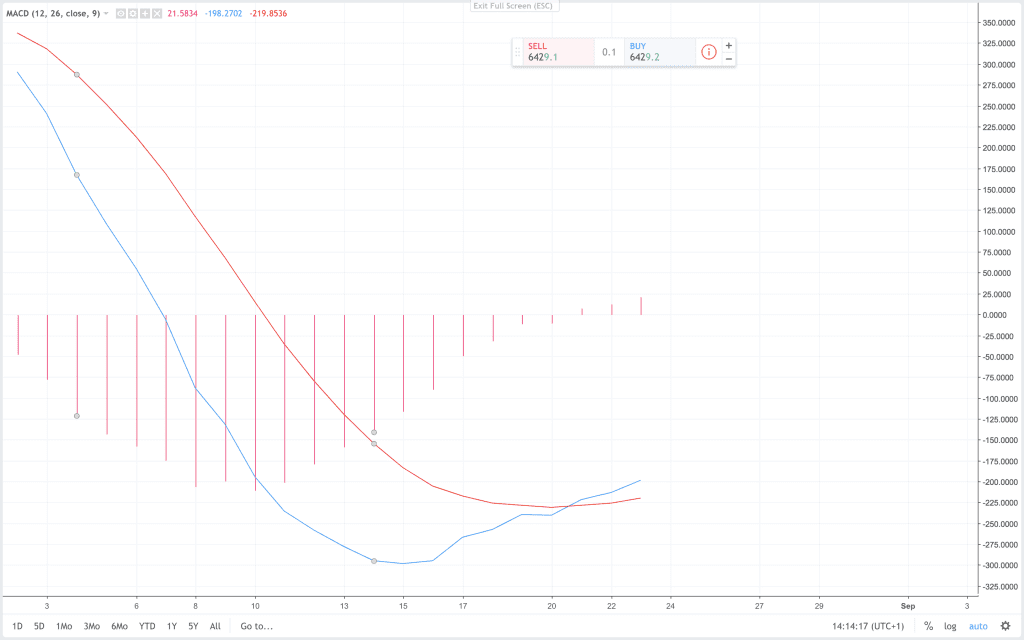Bullish Bitcoin MACD Suggests ETF Denial Insignificant

Share this article
Crypto has taken another tumble: the SEC’s rejection of nine Bitcoin ETFs sent the markets plunging in value. Around $10bn was wiped from the total value; bitcoin (BTC) saw a $300 drop over the few hours before and after the announcement.
Things aren’t looking too rosy, but a BTC bull run might be about to start, at least that’s what the bitcoin MACD line says.
A catchy-acronym for Moving Average Convergence Divergence, the MACD (pronounced either “MAC-D” or “M.A.C.D”) indicates the relationship between two moving averages. It is calculated by subtracting a shorter-term Exponential Moving Average (EMA) from a longer-term EMA, conventionally a 12-day from a 26-day EMA.
An exponential moving average is similar to a simple moving average; the difference is an EMA applies more weight to recent price data, points are all equally weighted with an MA.
At its most basic, the MACD indicates increasing momentum against an established price trend. Combined with a 9-EMA, known as the signal line, investors watch out for a ‘crossover’. When the signal line goes over the MACD line, this is considered a bearish signal; when the MACD crosses the signal line, it is considered bullish.
Data collected by TradingView found BTC is looking bullish. The bitcoin MACD line went above the signal line late on Tuesday and has so far stayed in the bull region, at least until the time of writing. The conventional 12-26 EMA formula shows the market recovering well, regardless of the SEC’s ETF rejection news; the more sensitive 5-35 EMA MACD (using a 5-EMA signal) indicates a slight drop in momentum, which has already started to pick up again.

(Daily, August 2018)
The bitcoin MACD correctly indicated three major bull trends since the start of the year. In mid-February, where following an unexpectedly bullish congressional hearing BTC rose above the $10,000 mark; at the start of a month-long bull-run in early April; and in mid-July when market euphoria waxed leading up to the first SEC ruling deadline for the CBOE bitcoin ETF.
Bitcoin MACD: Analysis
The muted loss highlights the rejection did not come as a surprise to many; markets fell by a similar $10bn when the Winkelvoss ETF was rejected back in late July, and there are some who feel the most recent rejection was already built-in to the price of Bitcoin.
The CBOE ETF is the one the community is most interested in. The SEC’s postponement of its decision until late September caused a near $60bn meltdown, bringing the total value down below $200bn: a yearly low.
What today’s promising MACD helps quantify is the market influence for bitcoin ETFS, excepting the CBOE application. A small negative knee-jerk reaction but prices soon stabilize, the momentum continuing almost unabated.
There are already rumors circulating over ETFs’ long-term efficacy for the crypto market: does the direct access investors have to BTC ownership nullify the whole purpose of an ETF, such as the one proposed by CBOE?
These are just indicators of course; moving averages representing historical data. There can be no complete guarantee that a positive signal from a MACD will manifest into anything of substance. They cannot show the strength behind the momentum, and traders can mistakenly invest into a movement which doesn’t turn into a strong trend: known as a “whipsaw”.
Chances are prices will increase in the immediate run-up to the next decision deadline for the CBOE bitcoin ETF, September 30th. The slight uptick could be the beginning of this trend; the likelihood is the decision will be delayed again and momentum will drop off.
The author is invested in BTC, which is mentioned in this article.
